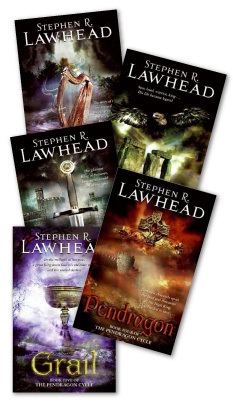 | ||
Similar Stephen R Lawhead books, Other books | ||
The Pendragon Cycle is a series of historical fantasy books based on the Arthurian legend, written by Stephen R. Lawhead. The Cycle was originally "The Pendragon Trilogy", but after Arthur's rather abrupt ending, and the existence of many unexplored stories and plotlines, Lawhead decided to expand on his trilogy by writing additional books. Avalon is not considered to be a true member of the Cycle, but rather a 'related semi-sequel' to it.
Contents
Overview
The series is a work of fiction that takes place in the 5th and 6th centuries and attempts to present the Arthurian legends in a historical setting while presenting the story with a reality the reader can connect with. Lawhead bases his stories on the Mabinogion, the History of the Kings of Britain and other works of Geoffrey of Monmouth, the writings of Taliesin, Gildas, and Nennius, and several other legends that he manages to interweave into the Arthurian legend.
The books, with the exception of Taliesin and Avalon, are narrated in the first-person, and, except for Pendragon, Grail, and Avalon, are each split into three sections (Pendragon has four, Grail one, and Avalon five). Merlin and Pendragon are narrated by Myrddin (Merlin). The first third of Arthur is narrated by Pelleas, the second by Bedwyr (Bedivere), and the third by Aneirin/Gildas. Grail is mostly narrated by Gwalchavad (Galahad), with a short narration by Morgian (Morgan le Fay) at the beginning of most chapters. Taliesin follows Taliesin and Charis (the Lady of the Lake), alternating in each chapter; Avalon mostly follows James Stuart (the reborn Arthur), Merlin, and the fictional Prime Minister Thomas Waring.
Locations
A listing of the locations and place names used in the series, and their modern equivalents:
(see also List of Roman place names in Britain)
Characters
Many historical personas (some already included in the Arthurian legend) exist in the Cycle, alongside less "factual" characters: Taliesin, Magnus Maximus, Theodosius, Ambrosius Aurelianus, Vortigern, Constantine III, Myrddin Wyllt, Clovis I, Gwyddno Garanhir, Elffin ap Gwyddno, Horsa, Hengest, Cerdic, Aelle, Gildas, and Aneirin (in the series, it is revealed that the last two are the same person; born with the name Aneirin, he changes it to Gildas after Arthur's death).
Novels
Book Descriptions
The series proceeds as told in the following descriptions:
Taliesin
Tells simultaneously the story of the fall of Atlantis, the subsequent travel of Princess Charis and her family to Ynys Prydein (Britain), and the discovery and training of Taliesin as a druid-bard. The two eventually meet, marry, and Myrddin (Merlin) is born, just weeks before a tragedy brought about by Charis' jealous half-sister, Morgian.
Merlin
Narrated by Myrddin. Tells of Myrddin's dual upbringing among the druids and Christian priests, his capture and mystical training among the Hill Folk, and his brief time as a king of Dyfed. He experiences a doomed romance with Princess Ganieda and long years of madness as a wild man of the woods before finding his destiny.
Arthur
Narrated by Pelleas (first third), Bedwyr (second third), and Aneirin (last third). Tells of Arthur and Myrddin's attempt to create the paradisaical "Kingdom of Summer." Arthur is made Duke and Battlechief of Britain after drawing the sword of Maximus from a stone, but must fight back the Saecsens and barbarian invaders and unite the peoples of Britain before he can be accepted as High King.
Pendragon
Narrated by Myrddin. Tells of an invasion of Ireland and Britain by the Vandal army of Twrch Trwyth, the Black Boar, and a subsequent plague that sweeps across Britain, threatening Arthur's Kingdom of Summer while it is still newborn.
Grail
Narrated by Gwalchavad (majority) and Morgian (short narration at each chapter's beginning). Tells of Arthur building a shrine to house the Holy Grail and how the beautiful and mysterious Morgaws joins his court. When treachery follows, Arthur's warriors brave the Wasteland of Lyonesse to retrieve the sacred relic.
Chronological order
Inconsistencies
It should be remembered that although Lawhead retains an authentic and well researched grasp of the Arthurian legend, he was not concerned with writing a work of pure history. Therefore, any historical inconsistencies in his work should be taken in this context.
